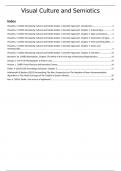Visual Culture and Semiotics
Index
Thwaites, T. (2002) Introducing Cultural and Media Studies: A Semiotic Approach. Introduction...................................2
Thwaites, T. (2002) Introducing Cultural and Media Studies: A Semiotic Approach. Chapter 1: Cultural Signs................2
Thwaites, T. (2002) Introducing Cultural and Media Studies: A Semiotic Approach. Chapter 2: Signs and Systems.........3
Thwaites, T. (2002) Introducing Cultural and Media Studies: A Semiotic Approach. Chapter 3: Interactions of Signs.....5
Thwaites, T. (2002) Introducing Cultural and Media Studies: A Semiotic Approach. Chapter 4: Texts and Textualities....7
Thwaites, T. (2002) Introducing Cultural and Media Studies: A Semiotic Approach. Chapter 5: Genre and
Intertextuality..................................................................................................................................................................9
Thwaites, T. (2002) Introducing Cultural and Media Studies: A Semiotic Approach. Chapter 6: Narrative.....................12
Benjamin, W. (1968) Illuminations. Chapter: The Work of Art in the Age of Mechanical Reproduction........................14
Sontag, S. (1977) On Photography. In Plato’s Cave........................................................................................................15
Mulvey, L. (1989) Visual Pleasure and Narrative Cinema..............................................................................................16
Childs, P. (2014) Said: knowledge and power. Chapter 3...............................................................................................17
Makhortykh & Bastian (2022) Personalizing The War: Perspectives for The Adoption of News Recommendation
Algorithms in The Media Coverage of The Conflict in Eastern Ukraine..........................................................................18
Kao, A. (2016) Tinder: True Love or a Nightmare?.........................................................................................................20
,Thwaites, T. (2002) Introducing Cultural and Media Studies: A
Semiotic Approach. Introduction
Culture
Culture = the ensemble of social practices by which meanings are produced, circulated and exchanged.
Culture overlaps into economic, legal and governmental areas.
Culture is the site of the production of meanings. Meanings come about in and through social relations;
meanings are never fixed and never fully determined by their social context.
Communication model:
sender à message à receiver
This model is not a good model as it does not answer any questions.
How are meanings produced in the social world?
What about possible interferences with the message?
Semiotics = the study of signs and symbols and their use or interpretation.
Thwaites, T. (2002) Introducing Cultural and Media Studies: A
Semiotic Approach. Chapter 1: Cultural Signs
The sign
Sign = anything which produces meanings.
Signs are not just comments on the world, but are themselves things in the world, specifically in the social
world.
Signs do not just convey meanings, but produce them.
Signs produce many meanings, not just one meaning per sign.
Signs have several functions:
1. Referential function
2. Metalingual function
3. Formal function
4. Expressive function
5. Conative function
6. Phatic function
7. Contextual function
Content
An obvious thing that a sign can do is refer to something else.
Referential function: the ability of a sign to invoke a content.
Codes
Signs suggest ways in which they may be read; they cue in certain codes for interpreting them (eg. difference e-mail
vs. handwritten letter). Important is the genre = the type of text. A sign’s meaning is far from a given fact. It is
something to be actively worked out/negotiated and always subject to renegotiation.
Metalingual function: suggests the codes by which the sign might be understood.
Format
Format is about the lay-out of the sign.
Formal function: the formal structure and the format of the sign.
This is tied closely to the material support of the sign: what it is made of (eg. cinema screen or television screen).
Address
Signs address:
The addresser of a text is the position it constructs as its source: where it says it is from.
2
, The sender is its actual source.
The addressee of a text is the position it constructs as its destination: where it says its going.
The receiver is its actual destination.
Sender and receiver are actual people. Addresser and addressee are constructions of signs.
A sign must construct the positions of addresser and addressee, as well as establish a relationship between the two.
Functions of address:
Expressive function: the sign’s construction of the addresser.
Conative function: the sign’s construction of the addressee.
Phatic function: the ways in which the sign constructs a relationship between addresser and addressee.
Context
All of the functions above depend on the social context of the sign. The social situations in which a sign is used may
determine the appropriate content, type of sign and coding, who is being addressed, by whom and how, and the
phatic community it constructs.
Contextual function: indicates the context in which the sign operates.
The seven functions
All of the functions are necessary for any sign activity to take place. A sign must:
Work within a system of references and codings.
Be describable in terms of formal attributes which allow us to distinguish it from other signs.
Set up relationships of address.
Operate within, and vary according to, specific concrete situations.
In any given sign, one or more of the functions may be more dominant. The functions are dependent of each other,
but are constantly interrelating:
Certain functions may work together very closely.
Certain functions may overlap to a degree.
Some functions may even work against others.
One function may trigger off another.
Thwaites, T. (2002) Introducing Cultural and Media Studies: A
Semiotic Approach. Chapter 2: Signs and Systems
Semiotics is a model, but it is not able to explain every aspect of sign practices. Semiotics overall is a useful way of
picturing some of the things which happen in them.
Sign and referent
Referentiality is one of the functions a sign may have; however it may not provide any explanation of how signs work.
On the contrary, reference is one of the things we must explain about signs.
3





